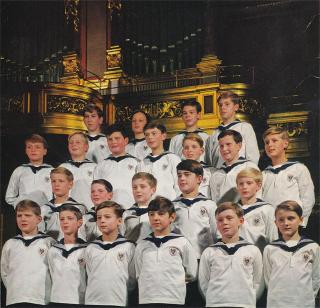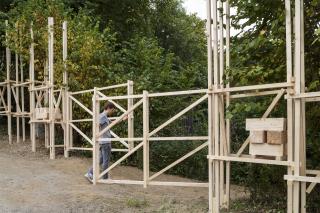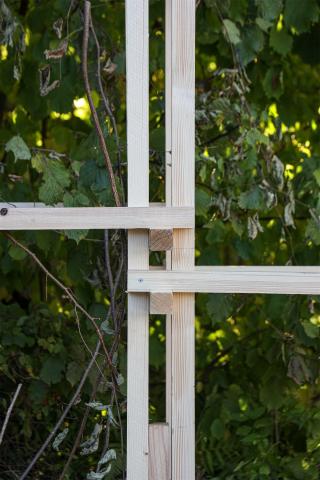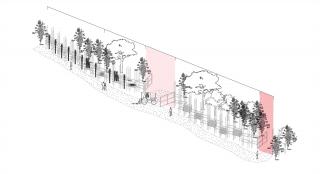奥地利维也纳校园湖岸艺术设计 | AA nanotourism Visiting School
-
项目名称:四季有声的文化校园
-
项目地点:奥地利维也纳童声合唱团夏季宿舍
-
设计公司:
-
建成时间:2021年
-
图片来源:AA nanotourism archive,Paul Sebesta
▼面朝湖景
Facing the lake © Paul Sebesta

韦尔特湖83%的湖岸线都对公众封闭。南岸边的维也纳童声合唱团夏令营地,虽未被充分利用,却是为数不多的能让人一瞥湖景的好去处。
该项目是对湖岸私有化的野蛮式发展的一种批判,也是对维也纳童声合唱团在社区中的存在感受到忽视的一种改变。
“交換栅栏”、“凝视”和“声炮”,这三个相互关联的建筑物设计是合唱团社群与当地公众之间的文化交流载体,让合唱团校园能在未来成为一个全年活跃的文化场所。
在两周的时间里,学生们设计并建造了三个建筑物,以解决和批判奥地利韦尔特湖的高度私有化问题。
Wörthersee has 83% of its shoreline inaccessible to the public. At the same time, located on the lake’s south shore, the Vienna Boys’ Choir Summer Residence is an underused property and one of the last remaining places with an opportunity to open up for the people.
The project critically addresses the lake’s wild privatisation and the current unawareness of the cultural presence of the Vienna Boys’ Choir in the local community.
The three interconnected interventions: ‘Exchange Fence’, ‘Stare!’ and ‘Sound Cannon’, offer tools for a new cultural exchange between the Boys’ Choir community and the local general public, capable of addressing the future transformation of the Vienna Boys Choir Campus into an all-year-round cultural venue.
Over two weeks, students design and build a series of three architectural interventions to address and critique the hyper-privatised nature of Austria’s Lake Wörthersee.
背景
Context
▼韦尔特湖现状
Status of Wörthersee © AA nanotourism archive


韦尔特湖是奥地利最著名的湖泊之一。历史上,它一直是传统木工产品的运输码头。自上个世纪以来,逐渐受到度假者的青睐。如今,过去家庭式的浪漫民宿正被大量的公寓和别墅所取代,变成仅为富人们享有的一片湖景,这导致 83% 的湖畔都是公众无法进入的!
当然,仍有一块隐秘的宝地留存着,是所剩无几的、能让公众走近韦尔特湖的地块之一。维也纳童声合唱团夏令营地坐落于湖的南岸,是一块有待充分开发的地方。合唱团的男孩们每年仅在暑假的两个月来到这里,避暑及练习歌唱技巧,而一年中的其余时间,6英亩大的校园被精心维护着,却无人使用。
Wörthersee is one of Austria's most prominent lakes. Historically, it has served as a transport infrastructure for traditional woodworking trades, while it has developed into a place of high interest for holidaymakers in the last century. Today, once family-run small romantic hotels are giving way to audacious developments of generic apartment blocks and villas for wealthy individuals who want the piece of the lake's shore for themselves only. Consequently, a staggering amount of 83% of the lake's perimeter is publicly inaccessible!
But there is a hidden gem - one of the last remaining plots with potential public access to the lake. Along the lake's fenced-off south perimeter road, Vienna Boys' Choir Summer Residence Campus is a place of underused potential. The boys practice their singing skills and spend time on the estate for two summer months per year only, while the rest of the year, the 6 acres of the Campus, remain empty and unoccupied - maintained for no one.
▼维也纳童声合唱团
Vienna Boys' Choir © WSK

虽然维也纳童声合唱团是世界最著名的合唱团体之一,邻近的韦尔特社区对他们的存在却知之甚少。他们的身份和高度专业的才能被隐没在校园茂密的植被之后。
曾任维也纳童声合唱团歌手、现任管理委员会成员的建筑师沃尔克·迪恩斯特,认识到这座庄园的独特机会及校园升级的必要性。他邀请AA设计公司来一起研究、实验并创建模型,以对校园特色进行有意义的渐进改造,从而为早已陈旧的运管注入新鲜的内容。
为了做好教学,AA设计公司的项目负责人、建筑师 Aljosa Dekleva 邀请了英国同事 Thomas Randall-Page 来共同指导该学校的韦尔特课题。他们与项目助理Amanda Sperger、Jakob Travnik 和导师Andreas Arndt合作,教授来自不同背景的15名年轻建筑师和建筑学生,并展开合作,研究如何将未充分利用的维也纳童声合唱团校园变成一个全年开放的文化场所。
Although the Vienna Boys' Choir is a world-famous high culture of choir singing, the neighbouring Wörthersee community have little knowledge of their presence. Their identity and highly specific skills are hidden behind the thick greenery of the Campus.
Former Vienna Boys' Choir singer and current management board member architect Volker Dienst identified the unique opportunity of the property and the necessity for the Campus' transformation. He opened up the discussion for possible changes in their rusted routine by inviting the AA nanotourism Visiting School to research, experiment and propose prototypes for a meaningful and gradual transformation of the campus' nature.
In preparation for the course, the Programme Head of the AA nanotourism Visiting School, architect Aljosa Dekleva, has invited a British colleague Thomas Randall-Page to co-mentor the Wörthersee edition of the school. Teamed up with programme assistants Amanda Sperger, Jakob Travnik and tutor Andreas Arndt they taught and worked together with fifteen young architects and architecture students from various international backgrounds on how an underused Vienna Boys Choir Campus can turn into an all-year-round cultural venue.
▼韦尔特湖装置设计
Three interconnected interventions of Wörthersee © Paul Sebesta

在为期两周的紧张暑期班中,师生调查了校园现有的自然与文化特征。 在3个旧有的建筑物上,各建造了一座概念性的建筑装置,并为参观者和维也纳童声合唱团未来可能的发展内容,提出了有关活动和策略上的建议。 这些建筑物是朝着更大目标迈出的第一步,即找到可行的校园发展战略。该战略将继续以举办维也纳童声合唱团成员的夏季活动为主,同时将其扩大成一个区域性的、多学科的新世纪文化校园,并向公众全年开放。
In an intense two-week summer school, they investigated the Campus's existing natural and cultural specificities. They developed one-to-one scale conceptual on-site intervention in the form of three built installations with events and strategies that proposed possible Campus' future developments for the visitors and members of Vienna Boys' Choir alike. This intervention is the first step towards the larger aim to find a responsible development strategy of the Campus that would continue to host the principal private activities of the Vienna Boys Choir members during summers, while it would also expand its role to a regional, multi-disciplinary cultural campus of the 21st century, open to the public and operational throughout all seasons.
▼韦尔特湖装置设计
Three interconnected interventions of Wörthersee © AA nanotourism archive


该团队创建了一个从概念到建造的创新设计,由三个独立但相互关联的建造物组成。“交換栅栏”批判性地拒绝了传统分割式的栅栏,向着增强社区凝聚力的多功能装置方向进行探索。“凝视!” 是对湖岸过度私有化的控诉,提供了一个私人资产供公众使用的范例。“声炮”则为童声合唱团提供了向公众表演的机会,并能邀请当地音乐家来一起合作,从而弥补维也纳童声合唱团在当地社区文化中受忽略的问题。
The team has created an architectural intervention from concept to construction consisting of three individual but correlated structures. The 'Exchange Fence' critically addresses the traditional type of the dividing fence and explores its transformations into a socially cohesive multifunctional element of the local community. The 'Stare!' critiques the over-privatisation of the lake's shores and offers a working example of privately owned public space. And the 'Sound Cannon' challenges the lack of cultural presence of the Vienna Boys' Choir in the local community by offering the opportunity for the Boys' Choir to perform for the public and invite local musicians for collaboration.
交換栅栏:好栅栏塑造好邻里
Exchange Fence:Good Fences Make Good Neighbours
▼交换栅栏
Exchange Fence © Paul Sebesta

既是栅栏,又是货架,“交换栅栏”通过鼓励物品交换来功能化公共边界。
Part fence, part store, ‘Exchange Fence’ mediates the public boundary by stimulating material exchanges.
▼交换栅栏
Exchange Fence © AA nanotourism archive

为了促进与邻近社区的交流,批判性方法如何将合唱团校园的维护通过围栏来给其自然资源重赋价值?
How can the critical approach to maintenance strategies and fencing of the Vienna Boys' Choir Campus re-value its natural resources to stimulate the exchange with the neighbouring community?
▼促进邻里关系的物品交换
Stimulate the Exchange with the Neighbouring Community © Paul Sebesta

维也纳童声合唱团校园占地 6 英亩,拥有丰富的自然资源,一年四季都在精心维护和修剪,尽管男孩们在校园的时间只有短短两个月。校园的维护工作会定期产出各种天然“废料“,从干草、嫩草、灌木、树皮到树枝树干,这些资源曾在当地农业经济中具有特定的价值。
The six-acre property of the Vienna Boys' Choir is full of natural resources that are carefully being maintained and manicured throughout the four seasons of the year regardless of the short period of two months when the boys are actually at the Campus. The upkeeping of the estate is regularly producing a set of natural "waste" materials, from hay, grass, shrubs and bark to branches and logs, that used to contain specific values in the local farming economy.
▼交换栅栏
Exchange Fence © Paul Sebesta


设计师采用了可持续性的方式来管理土地,建筑物用以存储和交换校园里的残留“废料”,从而改善邻里关系,促进交流。
In an approach to sustainably resolve land management issues, the intervention looks at the Campus' residue material as a resource for stimulating neighbouring relationships through storage and trade of those materials.
▼交换栅栏的连接结构
Connecting Structure of Exchange Fence © Paul Sebesta

该项目设计出一款新型栅栏:“深型栅栏”,取代了原来的单功能分隔栅栏,并融入了这一常规建筑物所具有的在环境、社会和经济层面上的潜在价值。这种三维结构除了仍是场地的屏障外,还能作为存储系统、店面和校园全年生产的天然废料的市场。它旨在激发新的交换,并就季节性的维护日程、废料和土地私有化概念进行探讨。
Replacing the existing monofunctional and dividing fence and recognising its typology's contextual, social and economic potential, the project proposes a different type: a 'deep fence'. This three-dimensional structure still functions as a barrier to the site, which additionally operates as a storage system, storefront and marketplace of natural waste materials produced at the Campus throughout the year. The publicly accessible structure aims to stimulate new rituals of exchange and debate on seasonal maintenance routines, waste and the notion of privatisation of land in the region.
凝视!原湖岸线的公共码头
Stare!Public Pier of a Former Shoreline
微型坐席“凝视!”是一个具有私人视野的公共空间,让观众一览湖色。
The micro auditorium, ‘Stare!’ is a public space with a private view, inviting the audience to a new lake vista.
▼“凝视!”观景台
‘Stare!’, the Micro Auditorium © Paul Sebesta

私有资产如何成为湖泊、维也纳童声合唱团和游客之间的可达性空间及教育空间?
How can a privately owned piece of property become a publicly accessible and educational interface between the lake, the Vienna Boys' Choir and the visitors?
▼“凝视!”观景台
‘Stare!’, the Micro Auditorium © AA nanotourism archive
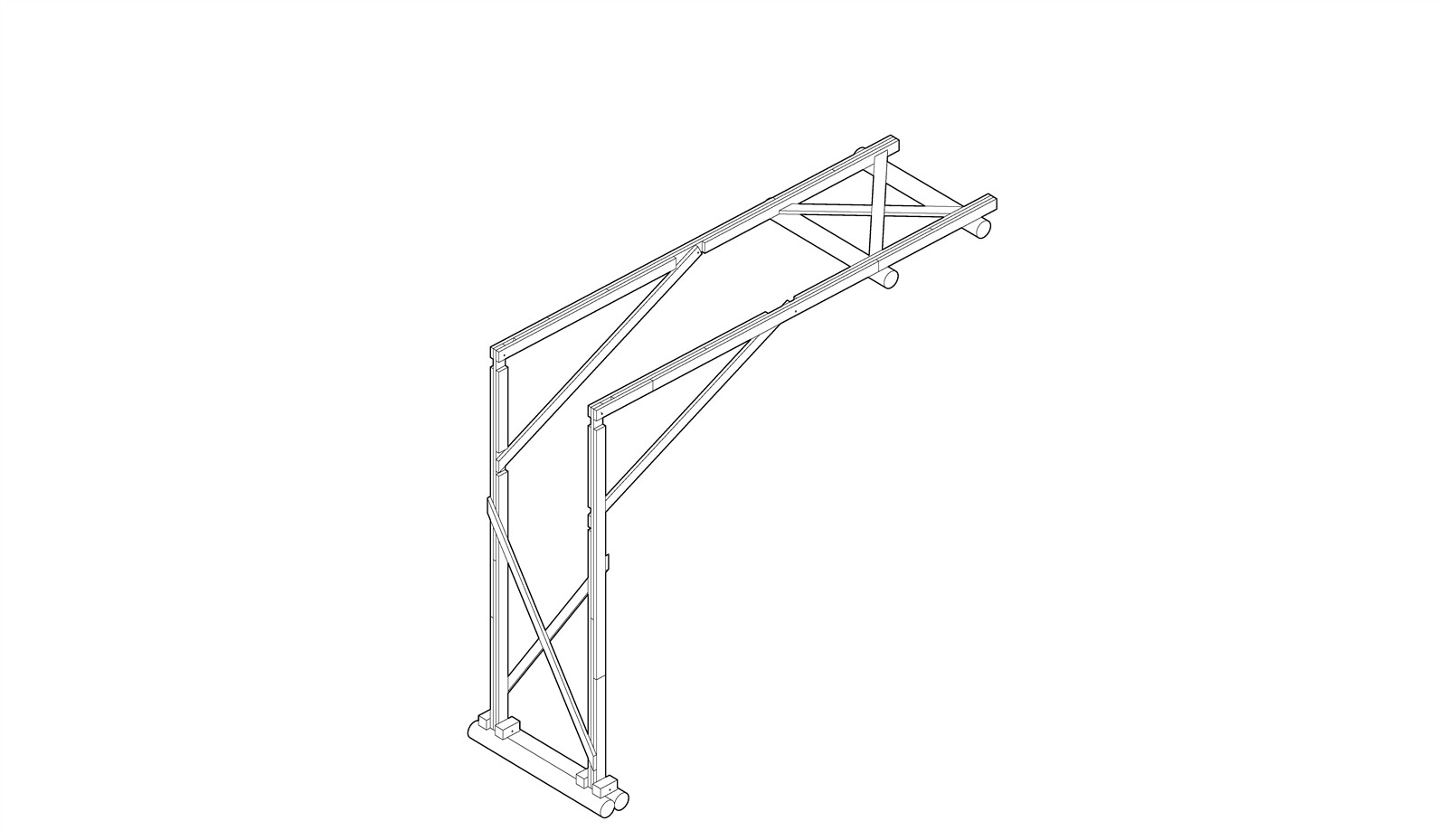


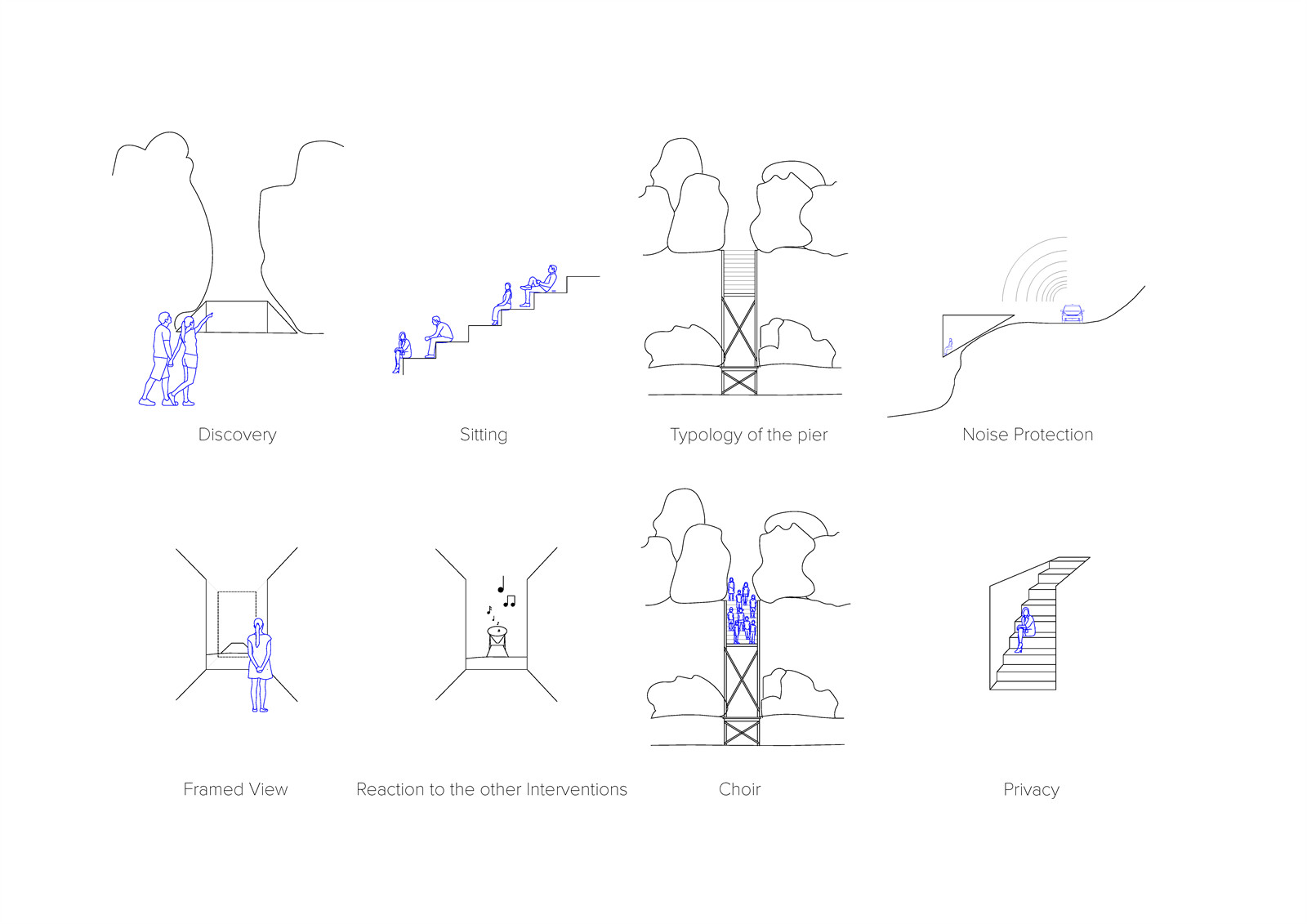
维也纳童声合唱团校园位于湖边最长道路(1.3 公里)的中间,这条道路没有一处能让人走近湖岸。针对将湖景私有化而产生的过多围栏式的岸边房产,该建筑物提供了多种选择。 首先,它设计了一个公众可用的观景平台,使过往的游客能从僻静的楼梯上欣赏湖景,拉近了观者与湖水的距离,又远离了道路的嘈杂。
Vienna Boys' Choir Campus is located halfway of the longest - 1.3 km long - stripe of the lake's perimeter road that offers not a single glance to the lake. Reacting to the excess of fenced-off shoreside properties that privatise the lake view, the intervention provides several alternatives. Firstly, it proposes a publicly accessible viewing platform that enables passing visitors to enjoy the lake's views from a secluded stairway by bringing the viewer closer to the water and away from the noisy road.
▼“凝视!”观景台
‘Stare!’, the Micro Auditorium © AA nanotourism archive


其次,自1770年人工降低水位后,韦尔特湖原来的水岸线便消失了,该建筑物正好标记了其初始位置,是一个码头改造的范例。因此,它不仅能用于休憩,还向游客诉说着几乎被遗忘的过去。
Secondly, as an altered exemplar of the pier typology, the project testifies about the former shoreline of Lake Wörth, which was lost in 1770 after the artificial lowering of the lake's water level. Therefore, the intervention is devoted to leisure, but it also educates visitors on almost forgotten past.
▼观景台结构细部
the Detail of the Micro Auditorium © AA nanotourism archive

最后,它也兼作礼堂,可容纳 20 人欣赏现有校园码头上的表演。码头和木制阶梯轴向对齐,如同能自然延伸至码头。该建筑物鼓励维也纳童声合唱团举办小型公共活动,以彰显他们的演唱才华,同时增强与韦尔特社区的关系。
Finally, it doubles as the auditorium that can host an audience of 20 people taking part in the performance happening on the existing campus' pier. The pier and the wooden stair-like structure are axially aligned to work together as one, spatially correlating setting. Opening up the possibility of hosting a performance encourages the Vienna Boys' Choir members to stage small public events to reinforce their singing identity and relation to the Wörthersee's community.
▼在观景台上休憩
Rest the Micro Auditorium © AA nanotourism archive


声炮:放大当地文化的声音
Sound Cannon:Amplifying the Local’s Culture Voice
▼“声炮”被安装在既有的木制码头上
The Sound Cannon is fixed on the existing wooden pier of the Campus © Paul Sebesta

站在齐膝深的湖中唱歌,“声炮”是韦尔特湖独特的声乐文化放大器。
Standing knee–deep in the lake and singing, ‘Sound Cannon’ is an analogue amplifier of the unique vocal culture of Wörthersee.
▼“声炮”分析图
Sound Cannon – Diagram © AA nanotourism archive




如何让歌声与音乐遍及整个韦尔特湖,以促进维也纳童声合唱团与公众开展新形式的文化交流?
How can singing and music be spread throughout lake Wörthersee to facilitate new forms of cultural exchange between the Vienna Boys' Choir and the general public?
▼可翻转的喇叭
The Horn is a Kinetic, Flipping Device © Paul Sebesta





该湖是韦尔特地区居民的共享空间。凭借其声效与空间品质,它已经是一个天然的声音发射器,可在一天中的不同时段来体验穿越湖面的丰富声音。另一方面,维也纳童声合唱团因其歌声而享誉国际,但湖边的社区大多还不知道他们的存在。
The lake is a shared space of the Wörthersee area inhabitants. With its acoustic and spatial qualities, it already functions as a natural sound transmitter, offering multiple experiences of sound travelling across the lake throughout different times of the day. On the other hand, Vienna Boys' Choir is internationally well known for their singing, but the lake's community is mostly unaware of their presence.
▼声炮细节
the Detail of the Sound Cannon © Paul Sebesta


怀着为合唱团发声的愿心,该建筑物将韦尔特湖想象成一个声音的传播者,将维也纳童声合唱团的高雅文化传送给湖边的社区。声炮固定在校园现有的木制码头上,成为本地音乐文化的放大器,为维也纳童声合唱团、当地音乐家和公众提供了新的互动形式。
With the ambition of giving the voice to the Choir, the project imagines the lake as a sound facilitator that distributes the high cultural identity of the Vienna Boys' Choir to the local community on the lake. Fixed on the existing wooden pier of the Campus, the Sound Cannon becomes an amplifier of the local music culture, providing an interaction point between the Vienna Boys' Choir, local musicians and the public.
▼声炮
the Sound Cannon © Paul Sebesta

喇叭是一个动态的翻转装置。它既可以面向湖面,将声音传播给湖泊社区的“偶然”听众,也可以面向维也纳童声合唱团校园的对外开放区域,并向观众表演。声炮所创生的新型表演方式,丰富了韦尔特的音景文化,同时也为进行各类音乐实验提供了机会。
The horn is a kinetic, flipping device. It can either face the lake and distribute the sound to 'accidental' listeners of the lake's community or face the land to perform to an audience on the Vienna Boys' Choir publicly accessible plot. Used in new performative rituals, the Sound Cannon contributes to the soundscape of Wörthersee and allows for musical experimentation that is a long tradition of the lake's history.
▼声炮为韦尔特的音景做出了贡献
the Sound Cannon contributes to the soundscape of Wörthersee © Paul Sebesta

项目信息
项目名称:四季有声的文化校园
项目地点:奥地利维也纳童声合唱团夏季宿舍
设计公司:AA nanotourism Visiting School
设计时间:2021.8.31-2021.9.15
建成时间:2021.8.31-2021.9.15
图片来源:AA nanotourism archive,Paul Sebesta
版权声明:本文版权归原作者所有,请勿以景观中国编辑版本转载。如有侵犯您的权益请及时联系,我们将第一时间删除。
投稿邮箱:info@landscape.cn
项目咨询:18510568018(微信同号)


